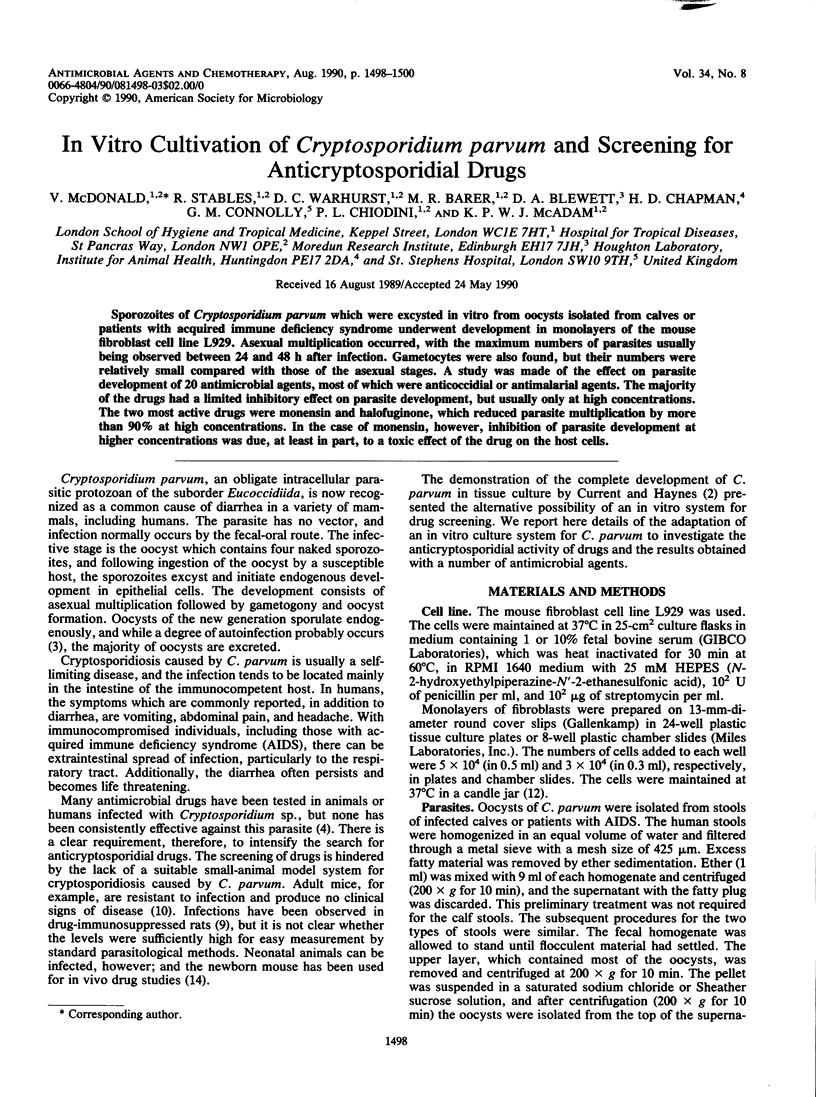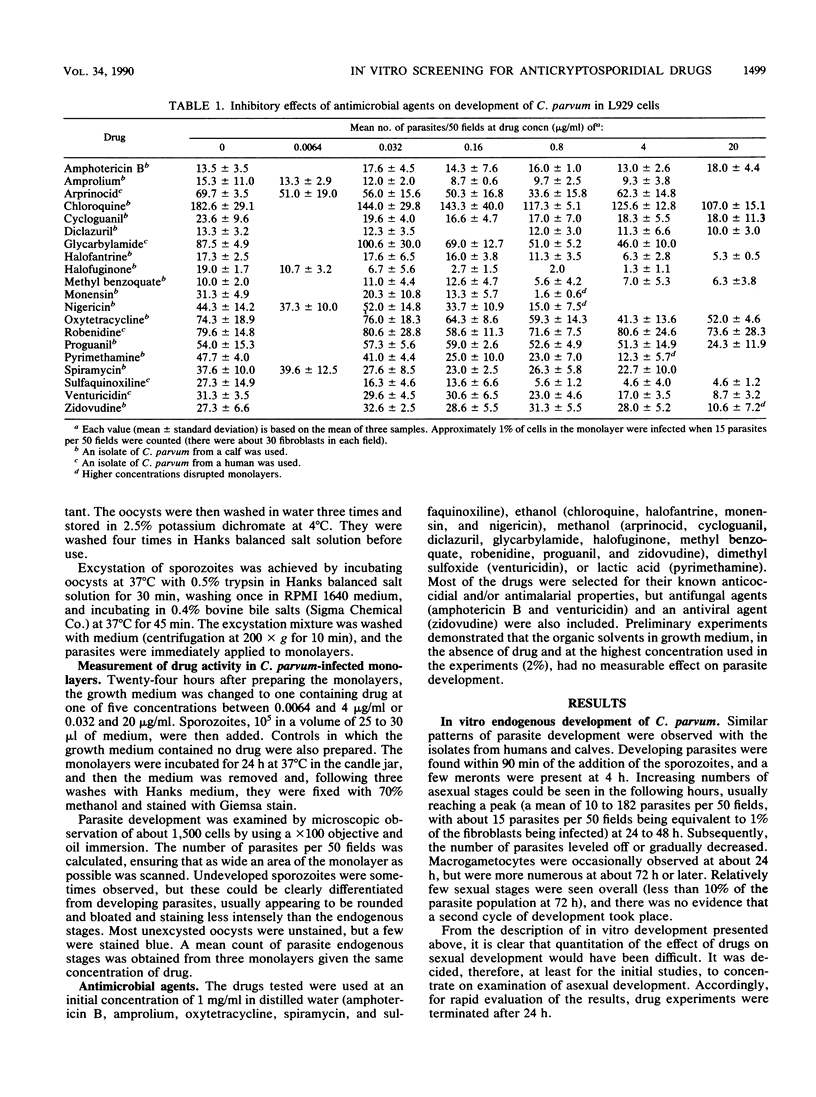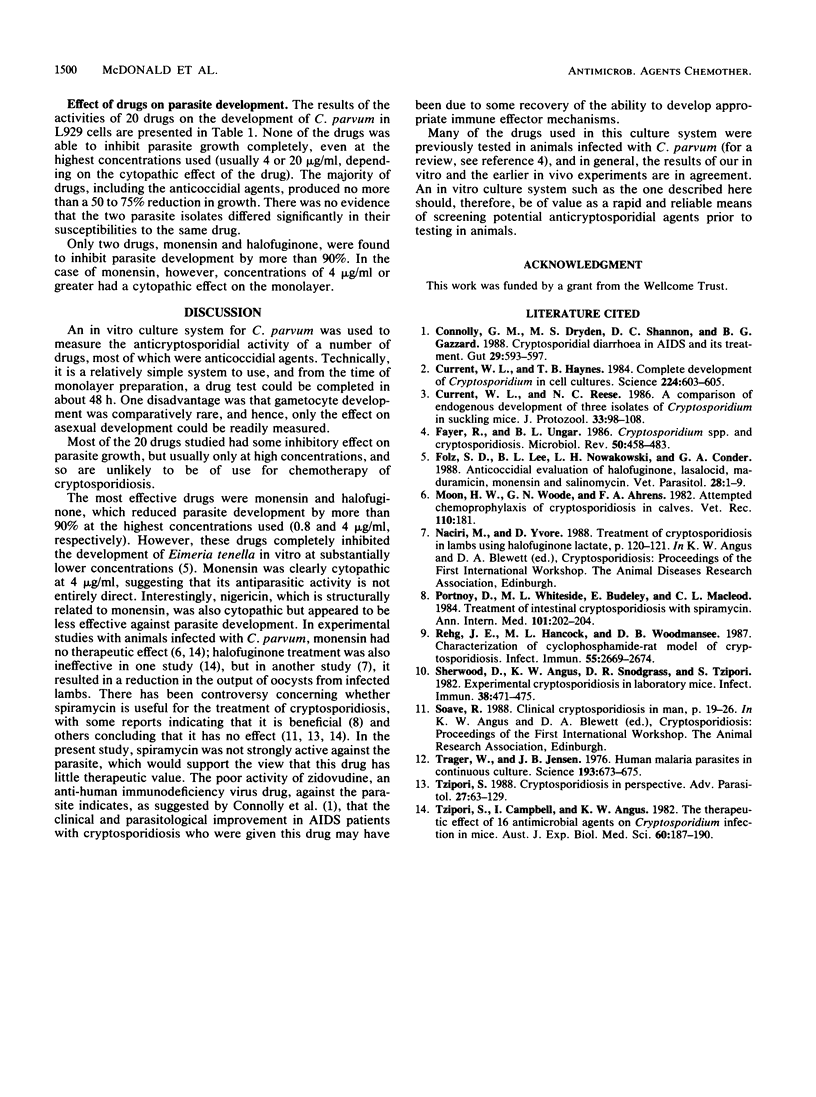Abstract
Sporozoites of Cryptosporidium parvum which were excysted in vitro from oocysts isolated from calves or patients with acquired immune deficiency syndrome underwent development in monolayers of the mouse fibroblast cell line L929. Asexual multiplication occurred, with the maximum numbers of parasites usually being observed between 24 and 48 h after infection. Gametocytes were also found, but their numbers were relatively small compared with those of the asexual stages. A study was made of the effect on parasite development of 20 antimicrobial agents, most of which were anticoccidial or antimalarial agents. The majority of the drugs had a limited inhibitory effect on parasite development, but usually only at high concentrations. The two most active drugs were monensin and halofuginone, which reduced parasite multiplication by more than 90% at high concentrations. In the case of monensin, however, inhibition of parasite development at higher concentrations was due, at least in part, to a toxic effect of the drug on the host cells.
Full text
PDF


Selected References
These references are in PubMed. This may not be the complete list of references from this article.
- Connolly G. M., Dryden M. S., Shanson D. C., Gazzard B. G. Cryptosporidial diarrhoea in AIDS and its treatment. Gut. 1988 May;29(5):593–597. doi: 10.1136/gut.29.5.593. [DOI] [PMC free article] [PubMed] [Google Scholar]
- Current W. L., Haynes T. B. Complete development of Cryptosporidium in cell culture. Science. 1984 May 11;224(4649):603–605. doi: 10.1126/science.6710159. [DOI] [PubMed] [Google Scholar]
- Current W. L., Reese N. C. A comparison of endogenous development of three isolates of Cryptosporidium in suckling mice. J Protozool. 1986 Feb;33(1):98–108. doi: 10.1111/j.1550-7408.1986.tb05567.x. [DOI] [PubMed] [Google Scholar]
- Fayer R., Ungar B. L. Cryptosporidium spp. and cryptosporidiosis. Microbiol Rev. 1986 Dec;50(4):458–483. doi: 10.1128/mr.50.4.458-483.1986. [DOI] [PMC free article] [PubMed] [Google Scholar]
- Folz S. D., Lee B. L., Nowakowski L. H., Conder G. A. Anticoccidial evaluation of halofuginone, lasalocid, maduramicin, monensin and salinomycin. Vet Parasitol. 1988 Apr;28(1-2):1–9. doi: 10.1016/0304-4017(88)90013-1. [DOI] [PubMed] [Google Scholar]
- Moon H. W., Woode G. N., Ahrens F. A. Attempted chemoprophylaxis of cryptosporidiosis in calves. Vet Rec. 1982 Feb 20;110(8):181–181. doi: 10.1136/vr.110.8.181-a. [DOI] [PubMed] [Google Scholar]
- Portnoy D., Whiteside M. E., Buckley E., 3rd, MacLeod C. L. Treatment of intestinal cryptosporidiosis with spiramycin. Ann Intern Med. 1984 Aug;101(2):202–204. doi: 10.7326/0003-4819-101-2-202. [DOI] [PubMed] [Google Scholar]
- Rehg J. E., Hancock M. L., Woodmansee D. B. Characterization of cyclophosphamide-rat model of cryptosporidiosis. Infect Immun. 1987 Nov;55(11):2669–2674. doi: 10.1128/iai.55.11.2669-2674.1987. [DOI] [PMC free article] [PubMed] [Google Scholar]
- Sherwood D., Angus K. W., Snodgrass D. R., Tzipori S. Experimental cryptosporidiosis in laboratory mice. Infect Immun. 1982 Nov;38(2):471–475. doi: 10.1128/iai.38.2.471-475.1982. [DOI] [PMC free article] [PubMed] [Google Scholar]
- Trager W., Jensen J. B. Human malaria parasites in continuous culture. Science. 1976 Aug 20;193(4254):673–675. doi: 10.1126/science.781840. [DOI] [PubMed] [Google Scholar]
- Tzipori S. R., Campbell I., Angus K. W. The therapeutic effect of 16 antimicrobial agents on Cryptosporidium infection in mice. Aust J Exp Biol Med Sci. 1982 Apr;60(Pt 2):187–190. doi: 10.1038/icb.1982.20. [DOI] [PubMed] [Google Scholar]
- Tzipori S. Cryptosporidiosis in perspective. Adv Parasitol. 1988;27:63–129. doi: 10.1016/S0065-308X(08)60353-X. [DOI] [PMC free article] [PubMed] [Google Scholar]


